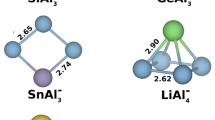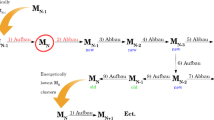Abstract
In this work, we explore the possibility of using computationally inexpensive electronic structure methods, such as semiempirical and DFTB calculations, for the search of the global minimum (GM) structure of chemical systems. The basic prerequisite that these inexpensive methods will need to fulfill is that their lowest energy structures can be used as starting point for a subsequent local optimization at a benchmark level that will yield its GM. If this is possible, one could bypass the global optimization at the expensive method, which is currently impossible except for very small molecules. Specifically, we test our methods with clusters of second row elements including systems of several bonding types, such as alkali, metal, and covalent clusters. The results reveal that the DFTB3 method yields reasonable results and is a potential candidate for this type of applications. Even though the DFTB2 approach using standard parameters is proven to yield poor results, we show that a re-parametrization of only its repulsive part is enough to achieve excellent results, even when applied to larger systems outside the training set.







Similar content being viewed by others
References
Wales DJ, Hodges MP (1998) Chem Phys Lett 286:65
Mitchell M (1998) An introduction to genetic algorithms. MIT Press, Cambridge, MA
Call ST, Zubarev DY, Boldyrev AI (2007) J Comput Chem 28:1177
Wales DJ, Doye JPK (1997) J Phys Chem A 101:5111
Silva MX, Galvão BRL, Belchior JC (2014) Phys Chem Chem Phys 16:8895
Paiva MAM, Peluzo BMTC, Belchior JC, Galvão BRL (2016) Phys Chem Chem Phys 18:31579
Silva FT, Galvão BRL, Voga GP, Silva MX, Rodrigues DDC, Belchior JC (2015) Chem Phys Lett 639:135
Silveira ADP, Gomes ACR, Galvão BRL (2018) Phys Chem Chem Phys 20:17464
Varandas AJC (2018) Eur Phys J D 72:134
Heiles S, Logsdail AJ, Schäfer R, Johnston RL (2012) Nanoscale 4:1109
Forck RM, Dieterich JM, Pradzynski CC, Huchting AL, Mata RA, Zeuch T (2012) Phys Chem Chem Phys 14:9054
Farrow MR, Chow Y, Woodley SM (2014) Phys Chem Chem Phys 16:21119
Yang M, Jackson KA, Koehler C, Frauenheim T, Jellinek J (2006) J Chem Phys 124:024308
Tarrat N, Rapacioli M, Cuny J, Morillo J, Heully J-L, Spiegelman F (2017) Comput Theor Chem 1107:102. structure prediction of nanoclusters from global optimization techniques: computational strategies
Galvão BRL, Viegas LP (2019) J Phys Chem A 123:10454
Aikens CM, Webb SP, Bell RL, Fletcher GD, Schmidt MW, Gordon MS (2003) Theor Chem Acc 110:233
Dunning TH, Peterson KA, Wilson AK (2001) J Chem Phys 114:9244
Raghavachari K, Trucks GW, Pople JA, Head-Gordon M (1989) Chem Phys Lett 157:479
Piecuch P, Kucharski S, Kowalski K, Musial M (2002) Comp Phys Comm 149:71
Bentz JL, Olson RM, Gordon MS, Schmidt MW, Kendall RA (2007) Comp Phys Comm 176:589
Olson RM, Bentz JL, Kendall RA, Schmidt MW, Gordon MS (2007) J Chem Theory Comput 3:1312
Varandas AJC (2007) J Chem Phys 126:244105
Varandas AJC, Pansini FNN (2014) J Chem Phys 141:224113
Pansini FNN, Neto AC, Varandas AJC (2016) Theor Chem Acc 135:261
Schmidt MW, Baldridge KK, Boatz JA, Elbert ST, Gordon MS, Jensen JH, Koseki S, Matsunaga N, Nguyen KA, Su S, Windus TL, Dupuis M, Montgomery J Jr (1993) J Comput Chem 14:1347
Aradi B, Hourahine B, Frauenheim T (2007) J Phys Chem A 111:5678
Gaus M, Cui Q, Elstner M (2011) J Chem Theory Comput 7:931
Lourenço MP, da Silva MC, Oliveira AF, Quinto MC, Duarte HA (2016) Theor Chem Acc 135:1432
Lourenço MP, de Oliveira C, Oliveira AF, Guimarães L, Duarte HA (2012) J. Phys. Chem. C 116:9405
Lourenço MP, Guimarães L, da Silva MC, de Oliveira C, Heine T, Duarte HA (2014) J Phys Chem C 118:5945
Guimarães L, Enyashin AN, Frenzel J, Heine T, Duarte HA, Seifert G (2007) ACS Nano 1:362
Gaus M, Goez A, Elstner M (2013) J Chem Theory Comput 9:338
Gaus M, Lu X, Elstner M, Cui Q (2014) J Chem Theory Comput 10:1518
Lu X, Gaus M, Elstner M, Cui Q (2015) J Phys Chem B 119:1062
Kubillus M, Kubař T, Gaus M, Řezáč J, Elstner M (2015) J Chem Theory Comput 11:332
dftb.org: the dftb website, http://www.dftb.org/, note = Accessed: 2020-04-24
Lourenço MP, dos Santos EC, Pettersson LGM, Duarte HA (2020) J Chem Theory Comput 16:1768
Dewar MJS, Zoebisch EG, Healy EF, Stewart JJP (1985) J Am Chem Soc 107:3902
Stewart JJP (1989a) J Comp Phys 10:209
Stewart JJP (1989b) J Comp Phys 10:221
Dewar MJS, Jie C (1989) J Mol Struct Theochem 187:1
Brothers EN, Merz KM (2002) J Phys Chem B 106:2779
Hutter MC, Reimers JR, Hush NS (1998) J Phys Chem B 102:8080
Dewar MJS, Holder AJ (1990) Organometallics 9:508
Dewar MJS, Jie C (1987) Organometallics 6:1486
Vilhelmsen LB, Hammer B (2014) J Chem Phys 141:044711
Viegas LP (2018) J Phys Chem A 122:9721
Vásquez-Pérez JM, Martínez GUG, Köster AM, Calaminici P (2009) J Chem Phys 131:124126
Marques JMC, Llanio-Trujillo JL, Abreu PE, Pereira FB (2010) J Chem Inf Model 50:2129
Fasp web site: Framework for automationof slater-koster file parameterization, http://fasp.alegre.ufes.br, accessed: 2020-04-24
Te Velde GT, Bickelhaupt FM, Baerends EJ, Fonseca Guerra C, van Gisbergen SJ, Snijders JG, Ziegler T (2001) J Comput Chem 22:931
Oliveira AF, Seifert G, Heine T, Duarte HAA (2009) J Braz Chem Soc 20:1193
Spiegelman F, Tarrat N, Cuny J, Dontot L, Posenitskiy E, Martí C, Simon A, Rapacioli M (2020) Adv Phys-X 5:1710252
Oliveira AF, Philipsen P, Heine T (2015) J Chem Theory Comput 11:5209
Gruden M, Andjeklovié L, Jissy AK, Stepanovié S, Zlatar M, Cui Q, Elstner M (2017) J Comput Chem 38:2171
Sun WG, Wang JJ, Lu C, **a XX, Kuang XY, Hermann A (2017) Inorg Chem 56:1241
Acknowledgments
We are grateful to Compute Canada/WestGrid for computational resources. The support of Centro Federal de Educação Tecnológica de Minas Gerais (CEFET-MG) and Rede Mineira de Química (RQ-MG) are also acknowledged. We acknowledge Prof. Hélio A. Duarte for providing the Acqua computational resources to use the Amsterdam Density Functional (ADF) software to obtain the repulsive potentials and the ACQUA-INCT (http://www.acqua-inct.org).
Funding
This study was financed in part by the Coordenação de Aperfeiçoamento de Pessoal de Nível Superior - Brasil (CAPES) - Finance Code 001, Conselho Nacional de Desenvolvimento Científico e Tecnológico (CNPq) - grants 403352/2016-9 and 305469/2018-5, Fundação de Amparo à Pesquisa do estado de Minas Gerais (FAPEMIG) - grant CEX - APQ-00071-15, and Fundação de Amparo à Pesquisa do Espírito Santo (FAPES) - project CNPq/FAPES PPP 22/2018. DRS thanks NSERC-Canada for ongoing Discovery Grants. LPV thanks the funding from Coimbra Chemistry Center through the CQC-SER-C2-BPD research grant.
Author information
Authors and Affiliations
Corresponding author
Additional information
Publisher’s note
Springer Nature remains neutral with regard to jurisdictional claims in published maps and institutional affiliations.
This article belongs to the Topical Collection: XX-Brazilian Symposium of Theoretical Chemistry (SBQT2019)
Rights and permissions
About this article
Cite this article
Galvão, B.R.L., Viegas, L.P., Salahub, D.R. et al. Reliability of semiempirical and DFTB methods for the global optimization of the structures of nanoclusters. J Mol Model 26, 303 (2020). https://doi.org/10.1007/s00894-020-04484-4
Received:
Accepted:
Published:
DOI: https://doi.org/10.1007/s00894-020-04484-4




